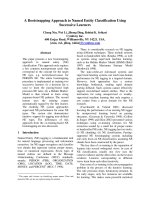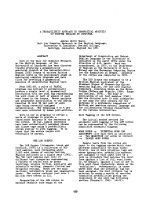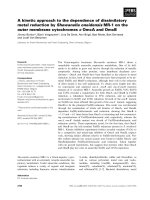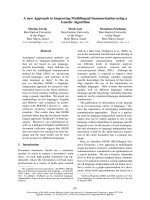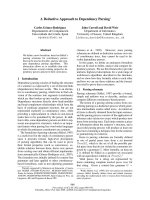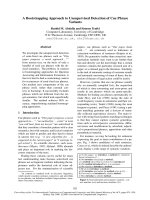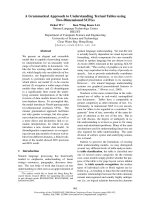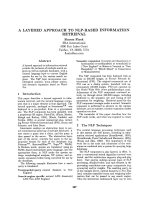Báo cáo khoa học: "A concurrent approach to the automatic extraction of subsegmental primes and phonological constituents from speech" docx
Bạn đang xem bản rút gọn của tài liệu. Xem và tải ngay bản đầy đủ của tài liệu tại đây (688.24 KB, 5 trang )
A concurrent approach to the automatic extraction of
subsegmental primes and phonological constituents from speech
Michael INGLEBY
School of Computing and Mathematics,
University of Huddersfield, Queensgate,
Huddersfield HD1 3DH, UK
Abstract
We demonstrate the feasibility of using unary primes
in speech-driven language processing. Proponents of
Government Phonology (one of several phonological
frameworks in which speech segments are
represented as combinations of relatively few
subsegmental primes) claim that primes are
acoustically realisable. This claim is examined
critically searching out signatures for primes in multi-
speaker speech signal data. In response to a wide
variation in the ease of detection of primes, it is
proposed that the computational approach to
phonology-based, speech-driven software should be
organised in stages. After each stage, computational
processes like segmentation and lexical access can be
launched to run concurrently with later stages of
prime detection.
Introduction and overview
In § 1, the subsegmental primes and phonological
constituents used in Government Phonology (GP) are
described, and the acoustic realisability claims which
make GP primes seem particularly attractive to
developers of speech-driven software are
summarised. We then outline an approach to defining
identification signatures for primes (§ 2). Our
approach is based on cluster analysis using a set of
acoustic cues chosen to reflect familiar events in
spectrograms: plosion, frication, excitation,
resonance We note that cues indicating manner of
articulation, which change abruptly at segment
boundaries, are computationaUy simple, while those
for voicing state and resonance quality are complex
and calculable only after signal segmentation. Also,
Wiebke BROCKHAUS
Department of German,
University of Manchester,
Oxford Rd, Manchester M13 9PL,
UK
the regions of cue space where the primes cluster (and
which serve as their signatures) are disconnected,
with separate sub-regions corresponding to the
occurrence of a prime in nuclear or non-nuclear
segmental positions.
A further complication is that GP primes combine
asymmetrically
in segments: one prime - the
HEAD -
of the combination being more dominant, while the
other element(s) - the
OPERATORS(S) -
tend to be
recessive. This is handled by establishing in cue space
a central location and within-cluster variance for each
prime. The training sample needed for this consists of
segments in which the prime suffers modification
only by minimal combination with others, i.e on its
own, or with as few other primes as possible. Then,
when a segment containing the prime in less than
minimal combination is presented for identification,
its location in cue space lies within a restricted
number of units of within-cluster variance of the
central location of the prime cluster. The number of
such distance units determines headedness in the
segment, with separate thresholds for occurrence as
head and as operator.
In § 3 we describe in more detail the stagewise
procedure for identifying
via
quadratic discriminants
the primes present in segments. At each stage, we
detail the computational processes which are driven
by the partial identification achieved by theend of the
stage. The processes include segmentation, selection
of lexical cohort by manner class, detection of
constituent structure, detection and repair of the
effects of phonological processes on the speech
signal. The prototype, speaker-independent, isolated-
word automatic speech recognition (ASR) system is
described in § 4. Called 'PhonMaster', it is
578
implemented in C++ using objects which perform
separate stages of lexical access and process repair
concurrently.
1 Phonological primes and constituents
Much of the phonological research work of the past
twenty years has focussed on phonological
representations: on the make-up of individual
segments and on the prosodic hierarchy binding
skeletal positions together.
Some researchers (e.g. Anderson and Ewen 1987
and Kaye
et al.
1985) have proposed a small set of
subsegmental primes which may occur in isolation
but can also he compounded to model the many
phonologically significant sounds of the world's
languages. To give an example, in one version of GP
(see Brockhaus
et al.
1996), nine primes or ELEMENTS
are recognised, viz. the .manner elements h (noise)
and ? (occlusion), the source elements H
(voicelessness), L (non-spontaneous voicing) and N
(nasality), and the resonance elements A (low), I
(palatal), U (labial) and R (coronal). These elements
are phonologically active - they can spread to
neighbouring segments, be lenited etc
The skeletal positions to which elements may be
attached (alone or in combination) enter into
asymmetric binary relations with each other, so-called
GOVERNING relations. A CONSTITUENT is defined as
an ordered pair, governor first on the left and
governee second on the right. Words are composed of
well-formed sequences of constituents. Which
skeletal positions may enter into governing relations
with each other is mainly determined by the elements
which occupy a particular skeletal slot, so elemental
make-up is an important factor in the construction of
phonological constituents.
GP proponents have claimed that elements, which
were originally described in articulatory terms, have
audible acoustic identities. As we shall see in § 2, it is
possible to define the acoustic signatures of individual
elements, so that the presence of an element can be
detected by analysis of the speech signal.
Picking out elements from the signal is much
more straightforward than identifying phonemes.
Firstly, elements are subject to less variation due the
contextual effects (e.g. place assimilation) of
preceding and following segments than phonemes.
Secondly, elements are much smaller in number than
phonemes (nine elements compared to c. 44
phonemes in English) and, thirdly, elements, unlike
phonemes, have been shown to participate in the kind
of phonological processes which lead to variation in
pronunciation (see references in Harris 1994).
Fourthly, although there is much variation of
phoneme inventory from language to language, the
element inventory is universal.
These four characteristics of its elements, plus the
availability of reliable element detection, make a
phonological framework such as GP a highly
attractive basis for multi-speaker speech-driven
software. This includes not only traditional ASR
applications (e.g. dictation, database access), but also
embraces multilingual speech input, medical (speech
therapy) and teaching (computer-assisted language
learning) applications.
2 Signatures of GP elements
Table 1 below details the acoustic cues used in
PhonMaster. Using training data from five speakers,
male and female, synthetic and real with different
regional accents, these cues discriminate between the
simplest speech segments containing an element in a
minimal combination with others. In the case of a
resonance element, say, U, the minimal state of
combination corresponds to isolated occurrence in a
vowel such as [U], as in RP English
hood
or German
Bus.
The accuracy of cues such as those in Table 1 for
discrimination of simplest speech segments has been
tested by different researchers using ratios of within-
class to between-class variance-covariance and
dendrograms (Brockhaus
et al.
1996, Williams 1997),
as described in PhonMaster's documentation.
The cues are calculated from fast Fourier
transforms (FFTs) of speech signals in terms of total
amplitude or energy distribution ED across low,
middle and high frequency parts of the vocal range
and the angular frequencies to(F) and amplitudes a(F)
of formants. The first four cues dp, to {h are
properties of a single spectral slice, and the change in
these four from slice to slice is logged as t} 5, which
peaks at segment boundaries. The duration cue #p6 is
segment-based, computable only after segmentation
from the length in slices from boundary to boundary,
579
normalising this length using the JSRU database of
the relative durations of segments in different manner
classes (see Chalfont 97). The normalisation is a
simple form of time-warping without the
computational complexity of dynamic time-warping
or Hidden Markov Models (HMMs).
Cue Label Definition
dpl Energy
qbl = EDIo / ED~
ratio~
dp 2 Energy
qb 2
-= EDmi d
/ ED~
ratio 2
dp 3 Width
(~3 = (to(F2) - (o(F l)) /
(to(F3) - to(F2))
~4 Fall
dP4 - a(F1) /(a(F3)+a(F2))
dP5 Change
If6qb
= (I)next.sliee ~)current-slice,
- + + 6q% +8 4
dP6 Duration
l~6 operates with reference
!to a durations database
dp7 F1
]q b7 = o(F 1)bo~.d/~o(F 1),t,,dy
Trajectory
qbs 'IfA~
= dPsteady - ~bound,
~bs = (Aco(F3) +Aco(F2))/
Formant
Transition
Table 1. Cues used to define signatures
The other segment-based cues contrast steady-
state formant values at the centre of a segment with
values at entrance and exit boundary. They describe
the context of a segment without going to the
computational complexity of triphone HMMs (e.g.
Young 1996). The PhonMaster approach is not tied
to a particular set of cues, so long as the members of
the set are concerned with ratios which vary much
less from speaker to speaker than absolute
frequencies and intensities. Nor is the approach
bound to FFTs - linear predictive coding would
extract energy density and formants just as well.
Signatures are defined from cues by locating in
cue space cluster centres and defining a quadratic
discriminant based on the variance-covariance
matrix of the cluster. When elements occur in higher
degrees of combination than those selected for the
training sample, separate detection thresholds for
distance from cluster centre are set for occurrence as
head and occurrence as operator.
3 Stagewise element recognition
The detection of dements in the signal proceeds in
three stages, with concurrent processes (lexical
access, phonological process repair ) being
launched after each stage and before the full identity
of a segment has been established.
The overall architecture of the recognition task is
shown in Figure 1. At Stage 1, the recogniser checks
for the presence of the manner elements h and ?.
1. Maalte¢
2.
Pbenttlelt
Figure 1. Stagewise cue invocation strategy
This launches the calculation of cues 4)5 (for the
automatic segmentation process) and 4)6 (to
distinguish vowels from approximants, and to
determine vowel length). The ensuing manner class
assignment process produces the classes:
Occ Occlusion (i.e. ? present as head, as in
plosives and affricates)
Sfr Strong fricative (i.e. h present as head, as
in [s], [z], IS] and [Z])
Wfr Weak fricative (i.e. h present as operator,
as in plosives and non-sibilant fricatives)
580
Plo
Nas
App
Svo
LVo
Vow
Plosion (as for Wfr, but interpreted as
plosion when directly following Occ-
except word-initially)
Nasal (i.e. ? present as operator)
Approximant
Short vowel
Long vowel or diphthong
Vowel (not readily identifiable as being
either long or short).
the words can be identified uniquely by manner class
alone. This is the case for languages such as English,
German, French and Italian, so the accessing of an
individual word may be successful as early as Stage
1, and no further data processing need be carried out.
If, however, as in Figure 3, the manner-class
sequence identified is a common one, shared by
several words, then the recognition process moves
Figure 2. Representation
of potential
after Stage 1
As soon as such a sequence of manner classes
becomes available, repair processes and lexical
searches can be launched concurrently. The repair
object refers to the constituent structure which can
be built on the basis of manner-class information
alone and checks its conformance to the universal
principles of grammar in GP as well as to language-
specific constraints. In cases of conflict with either,
a new structure is created to resolve the conflict
For example, the
word potential
is often realised
without a vowel between the first two consonants.
This elided vowel would be restored automatically
by the repair object, as illustra'~d in Figure 2, where
a nuclear position (N) has been inserted between the
two onset (O) positions occupied by the plosives.
Constituent structure is less specific than manner
classes (in certain cases, different manner-class
sequences are assigned the same constituent
structure), so manner classes form the key for lexical
access at Stage 1. Zue (1985) reports that, even in a
large lexicon of c. 20, 000 words, around a third of
Figure 3. Lexical search screen for a common manner
class sequence (Stage 1)
on to Stage 2, where the phonatory properties of the
segments identified at Stage 1 are determined.
Continuing with the example in Figure 3, the
lexical access object would now discard words such
as
seed
or
shade,
as neither of them contains the
element H (voicelessness in obstruents), whose
presence has been detected in both the initial
fricative and the final plosive at Stage 2. Again, it
may be possible to identify a unique word candidate
at the end of Stage 2, but if several candidates are
available, recognition moves on to Stage 3.
Here, the focus is on the four resonance
elements. As the manifestations of U, R, I and A
vary between voiced vs. voiceless obstruents vs.
sonorants, appropriate cues are invoked for each of
these three broad classes (some of the cues reusing
information gathered at Stage 1). The detection of
certain resonance elements then provides all the
necessary information for a final lexical search. In
our example, only one word,
seep,
contains all the
elements detected at Stages 1 to 3, as illustrated in
581
Figure 4. Only in cases of homophony will more
than one word be accessed at Stage 3.
Figure 4. Lexical search screen for a common manner
class sequence (Stage 3)
Concurrently with this lexical search, repair
processes check for the effects of assimilation,
allowing for adjacent segments (especially in
clusters involving nasals and plosives)to share one
or more resonance elements, thus resolving possible
access problems arising from words such as
input
/'InpUt/being
realised as
['IrnpUt].
4 PhonMaster and its successors
The PhonMaster prototype was implemented in C++
by a PhD student educated in object-oriented design
and Windows application programming. It uses
standard object-class libraries for screen
management, standard relational database tools for
control of the lexicon and standard code for FFT as
in a spectrogram display object. Users may add
words using a keypad labelled with IPA symbols.
Manner class sequences and constituent structure are
generated automatically. The objects concerned wilh
the extraction of cues from spectra, segmentation,
manner-class sequencing and display of constituent
structure, repairing effects of lenition and
assimilation are custom built.
PhonMaster does not use corpus trigram statistics
(e.g. Young 1996) to disambiguate word lattices, and
there is no speaker-adaptation. Without these
standard ways of enhancing pure pattern-recognition
accuracy, its success rate for pure word recognition
is around 75%. We are contemplating the addition d"
pitch cues, which, with duration, would allow
detection of stress, which may further increase
accuracy.
Object orientation makes the task of
incorporating currently popular pattern recognition
methods fairly straightforward. HMMs whose
hidden states have cues like ours as observables are
obvious things to try. Artificial Neural Nets (ANNs)
also fit into the task architecture in various places.
Vector quantisation ANNs could be used to learn the
best choice of thresholds for head-operator detection
and discrimination. ANNs with output nodes based
on our quadratic discriminants in place of the more
common linear discriminants are also an option, and
their output node strengths would be direct measures
of presence of elements.
References
Anderson J.M. and Ewen C.J. (1987)
Principles of
Dependency Phonology.
Cambridge University
Press, Cambridge, England, 312 pp.
Brockhaus W.G., Ingleby M. and Chalfont C.R.
(1996) Acoustic signatures of phonological
primes. Internal report. Universities of
Manchester and Huddersfield, England.
Chalfont C.R. (1997) University of Huddersfield
PhD Dissertation 'Automatic Speech Recogni-
tion: a Government Phonology perspective'
Harris J. (1994)
English Sound Structure.
Blackwell,
Oxford, England.
Kaye J.D., Lowenstamm J. and Vergnaud J R.
(1985) The
internal structure of phonological
elements: a theory of charm and government.
Phonology Yearbook, 2, pp. 305-328.
Williams G. (1997)A
pattern recognition model for
the phonetic interpretation of elements.
SOAS
Working Papers in Linguistics and Phonetics, 7,
pp. 275-297.
Young S. (1997) A Review of Large-vocabulary
Continuous-speech Recognition. IEEE Signal
Processing Magazine, September Issue.
Zue V.W. (1985) The
use of speech knowledge in
Automatic Speech Recognition,
Proc. ICASSP,
73/11, pp. 1602-1615.
582
